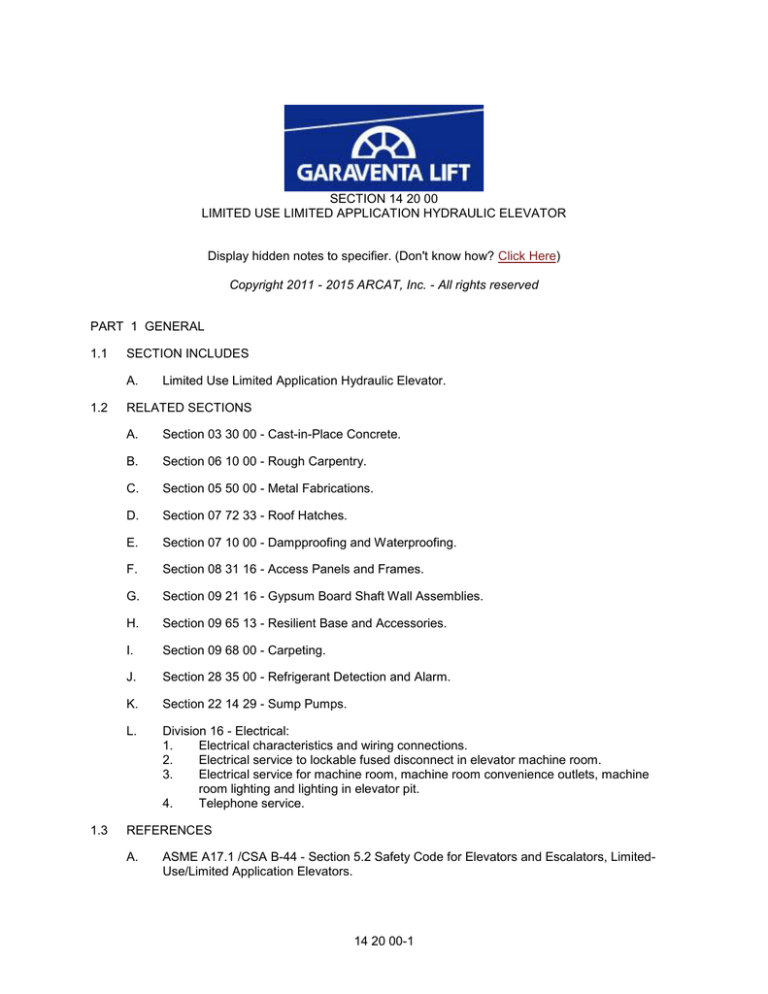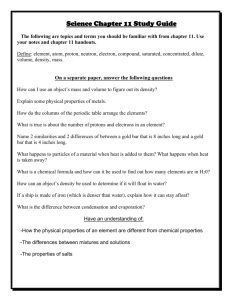
SECTION 14 20 00
LIMITED USE LIMITED APPLICATION HYDRAULIC ELEVATOR
Display hidden notes to specifier. (Don't know how? Click Here)
Copyright 2011 - 2015 ARCAT, Inc. - All rights reserved
PART 1 GENERAL
1.1
SECTION INCLUDES
A.
1.2
1.3
Limited Use Limited Application Hydraulic Elevator.
RELATED SECTIONS
A.
Section 03 30 00 - Cast-in-Place Concrete.
B.
Section 06 10 00 - Rough Carpentry.
C.
Section 05 50 00 - Metal Fabrications.
D.
Section 07 72 33 - Roof Hatches.
E.
Section 07 10 00 - Dampproofing and Waterproofing.
F.
Section 08 31 16 - Access Panels and Frames.
G.
Section 09 21 16 - Gypsum Board Shaft Wall Assemblies.
H.
Section 09 65 13 - Resilient Base and Accessories.
I.
Section 09 68 00 - Carpeting.
J.
Section 28 35 00 - Refrigerant Detection and Alarm.
K.
Section 22 14 29 - Sump Pumps.
L.
Division 16 - Electrical:
1.
Electrical characteristics and wiring connections.
2.
Electrical service to lockable fused disconnect in elevator machine room.
3.
Electrical service for machine room, machine room convenience outlets, machine
room lighting and lighting in elevator pit.
4.
Telephone service.
REFERENCES
A.
ASME A17.1 /CSA B-44 - Section 5.2 Safety Code for Elevators and Escalators, LimitedUse/Limited Application Elevators.
14 20 00-1
1.4
1.5
1.6
1.7
B.
NFPA 70 - National Electric Code.
C.
CSA - Canadian Electric Code.
D.
ADAAG - Americans with Disabilities Act, Architectural Guidelines.
REGULATORY REQUIREMENTS
A.
Provide passenger elevator in compliance with:
1.
ASME A17.1 - Safety Code for Elevators and Escalators, Limited-Use/Limited
Application Elevators.
2.
NFPA 70 - National Electric Code.
B.
Provide passenger elevator in compliance with:
1.
CSA B-44 - Safety Code for Elevators and Escalators, Limited-Use/Limited
Application Elevators.
2.
CSA - Canadian Electric Code.
C.
ADA: Provide passenger elevator in accordance with the requirements of Americans with
Disabilities Act.
SUBMITTALS
A.
Submit under provisions of Section 01 30 00.
B.
Product Data: Manufacturer's data sheets on elevator, including:
1.
Preparation instructions and recommendations.
2.
Storage and handling requirements and recommendations.
3.
Installation methods.
C.
Shop Drawings:
1.
Show typical details of assembly, erection and anchorage.
2.
Include wiring diagrams for power, control, and signal systems.
3.
Show complete layout and location of equipment, including required clearances and
coordination with shaftway.
D.
Selection Samples: For each finish product specified, two complete sets of color chips
representing manufacturer's full range of available colors and patterns.
E.
Manufacturer's Certificates: Certify products meet or exceed specified requirements.
F.
Closeout Submittals: Provide manufacturer's maintenance instructions that include
recommendations for periodic checking and adjustment of cable tension and periodic
cleaning and maintenance of all railing and infill components.
PRE-INSTALLATION MEETINGS
A.
Convene minimum two weeks prior to start of work of this section.
B.
Review shaftway, electrical, fire alarm and other requirements with appropriate
representatives.
DELIVERY, STORAGE, AND HANDLING
A.
Store products in manufacturer's unopened packaging until ready for installation.
B.
Store components off the ground in a dry covered area, protected from adverse weather
conditions.
14 20 00-2
1.8
PROJECT CONDITIONS
A.
1.9
Do not use elevator for hoisting materials or personnel during construction period.
WARRANTY
A.
Warranty: Provide a two year limited warranty covering replacement of defective parts and
excluding labor. Preventive maintenance agreement required.
B.
Extended Warranty: Provide an additional five year limited warranty covering replacement of
defective parts and excluding labor for a total of seven years. Preventive maintenance
agreement required.
1.10 MAINTENANCE SERVICE
A.
Furnish service and maintenance for elevator system and components for the following
period from Date of Substantial Completion.
1.
One year.
2.
Two years.
3.
Three years.
4.
Four years.
5.
Five years.
6.
Six years.
7.
Seven years.
B.
Include systematic examination, adjustment, and lubrication of elevator equipment. Repair or
replace parts whenever required. Use parts produced by manufacturer of original equipment.
Replace wire ropes when necessary to maintain required factor of safety.
C.
Provide emergency call back service for this maintenance period.
D.
Perform maintenance work using competent and qualified personnel approved by elevator
manufacturer or original installer.
PART 2 PRODUCTS
2.1
2.2
MANUFACTURERS
A.
Acceptable Manufacturer: Garaventa Lift; United States - P.O. Box 1769, Blaine, WA
98231-1769. Canada - 7505 134A St., Surrey, BC V3W 7B3. ASD. Toll Free: 800-6636556. Tel: (604) 594-0422. Fax: (604) 594-9915. Email:productinfo@garaventalift.com.
Web www.garaventalift.com.
B.
Substitutions: Not permitted.
C.
Requests for substitutions will be considered in accordance with provisions of Section 01 60
00.
LIMITED USE LIMITED APPLICATION HYDRAULIC ELEVATORS
A.
Garaventa Elvoron LU/LA Hydraulic Elevator, 1,400 pounds (635 kg) capacity cable
hydraulic elevator:
1.
Capacity: 1,400 pounds (635 kg).
2.
Car Size: Maximum of 18 SF (1.67 sm).
a.
Style 1L: 48 inches by 54 inches (1220 by 1372 mm) with one side right sliding
doors.
b.
Style 1L: 42 inches by 60 inches (1067 by 1524 mm) with one side right sliding
doors.
14 20 00-3
c.
3.
4.
5.
6.
7.
8.
9.
10.
11.
12.
13.
Style 1R: 48 inches by 54 inches (1220 by 1372 mm) with one side left sliding
doors.
d.
Style 1R: 42 inches by 60 inches (1067 by 1524 mm) with one side left sliding
doors.
e.
Style 2: 48 inches by 54 inches (1220 by 1372 mm) with sliding doors at each
end.
f.
Style 2: 42 inches by 60 inches (1067 by 1524 mm) with sliding doors at each
end.
g.
Style 3: 51 inches by 51 inches (1295 by 1295 mm) with sliding doors on two
sides.
h.
Style 4: 51 inches by 51 inches (1295 by 1295 mm) with sliding doors on two
sides.
Travel:
a.
_____ feet ____ inches.
b.
As indicated on the Drawings.
Stops:
a.
2 stops.
b.
3 stops.
c.
4 stops.
d.
5 stops.
e.
6 stops.
f.
As indicated on the Drawings.
Speed: Nominal 30 feet per minute (0.15 m/sec).
Pit Depth: Minimum 14 inches (355 mm) required.
Overhead: Total overhead clearance (Refuge Space) 135 inches (3429 mm) above
the finished upper landing floor level. This space allowance can be reduced to 114
inches (2896 mm) with the use of a car top prop.
Drive System: 1:2 Cable Hydraulic, Heavy Duty car sling with roller guide shoes
running on 8 lb. per foot steel T-rails, Quiet submersed pump and motor (5 HP),
Factory pre-set and tested 2-speed valve for smooth start and stop.
Power Requirements:
a.
230 VAC, 30 Amp, Single Phase.
b.
208 VAC, 20 Amp, Three Phase.
c.
A Separate 115-Volt, 15 Amp Circuit is required for car lighting.
Controls:
a.
Garaventa-Design PLC Controller with integrated self-diagnostics.
b.
Fully automatic push button at car and landings with Braille markings..
c.
Automatic car light switch upon entry.
d.
Digital floor indicator in Car.
e.
Car arrival lanterns in car door jamb.
f.
Arrival gong.
Car and Hoistway Doors: Nominal 36 inch by 80 inch (914 by 2032 mm) two-speed
horizontal sliding hoistway and car doors.
Safety Features:
a.
Emergency back-up power with a manual lowering device.
b.
Safety brake system.
c.
Car operator with integral gate switch.
d.
Automatic bi-directional floor leveling.
e.
Emergency alarm button in car, Emergency keyed stop switch in car.
f.
Overspeed valve.
g.
Final limit switch.
h.
Low oil protection timer circuit.
Standard Features:
a.
Car direction lantern comes with audio and visual signals.
b.
Full height photo-electric door sensors.
c.
Automatic home park feature. Home park can be disengaged during
14 20 00-4
14.
15.
2.3
CAB DESIGN
A.
2.4
installation.
Options:
a.
Integrated hands free telephone.
b.
Fireman service (Phase 1).
c.
Car top prop (required where overhead clearance is less than 135 inches).
d.
Buffer springs (increases your pit depth).
e.
Keyed hoistway access
Machine Location:
a.
As indicated on the Drawings.
Cab Design:
1.
Interior Walls: Laminate panel sections.
a.
Designer White.
b.
Dove Gray.
c.
Cloud Nebula.
d.
Kensington Maple.
e.
New Age Oak.
f.
Empire Mahogany.
g.
Custom as selected by the Architect.
2.
Cab Frame:
a.
Mild steel powder coated black.
b.
Mild steel powder coated white.
c.
Stainless Steel.
d.
Mild steel powder coated in a custom color as selected by the Architect.
e.
Custom as selected by the Architect.
3.
Ceiling Finish:
a.
White.
b.
Stainless Steel, brushed finish.
c.
Custom as selected by the Architect.
4.
Handrail Finish:
a.
Stainless Steel, brushed finish.
b.
Bronze, oil rubbed finish.
5.
Car Operating Panel Finish:
a.
Stainless Steel, brushed finish.
b.
Bronze, oil rubbed finish.
6.
Floor: Unfinished plywood construction.
7.
Lighting: Four recessed LED down lights.
a.
White Trim.
b.
Black Trim.
c.
Chrome Trim.
8.
Car Direction Lantern: Stainless car direction lantern complete with auto and visual
signaling device indicating direction of travel and arrival at selected floor.
9.
Car Doors: When open the doors provide a 36 inch (915 mm) by 80 inch (2032 mm)
clear opening.
a.
Two Speed Horizontal Sliding equipped with full height photo-electric door
sensors, color as follows:
1)
Matching cab wall finish.
2)
Stainless steel, brushed finish.
HOISTWAY ENTRANCES
A.
Hoistway Entrances: When open, the doors provide a 36 inch (915 mm) by 80 inch (2032
mm) clear opening.
1.
Two Speed Horizontal Sliding equipped with full height photo-electric door sensors,
14 20 00-5
finish as follows:
a.
Primed painted.
b.
Stainless Steel, brushed finish.
B.
Hall Call Stations:
1.
Hall Station Type:
a.
Keyless Push Button.
b.
Keyed Push Button.
2.
Finish:
a.
Stainless Steel, brushed finish.
b.
Bronze, oil rubbed finish.
PART 3 EXECUTION
3.1
3.2
3.3
3.4
EXAMINATION
A.
Do not begin installation until preliminary work including hoistway, landings and machine
space has been properly prepared.
B.
Verify hoistway is constructed in accordance with ASME A17.1 /CSA B-44 and all local
codes.
C.
Verify hoistway and machine room environment is designed to have maintainable
temperatures between 50 degrees F (15 degrees C) and 90 degrees F (32 degrees C) and
between 5 percent and 90 percent non-condensing.
D.
Verify machine room, when required, is provided with lighting, light switch, convenience
outlets and clear space requirements of all local codes.
E.
Verify hoistway and openings are of correct size and within tolerance.
F.
Verify electrical power is available and of correct characteristics.
G.
If preliminary work is the responsibility of another installer, notify Architect of unsatisfactory
preparation before proceeding.
PREPARATION
A.
Clean surfaces thoroughly prior to installation.
B.
Prepare surfaces using the methods recommended by the manufacturer for achieving the
best result for the substrate under the project conditions.
INSTALLATION
A.
Install elevator in accordance with applicable regulatory requirements including ASME A
17.1 /CSA B-44 and the manufacturer's instructions.
B.
Install system components and connect to building utilities.
C.
Accommodate equipment in space indicated.
D.
Startup equipment in accordance with manufacturer's instructions.
E.
Adjust for smooth operation.
FIELD QUALITY CONTROL
A.
Perform tests in compliance with ASME A 17.1 /CSA B-44 and as required by authorities
14 20 00-6
having jurisdiction.
B.
3.5
3.6
3.7
3.8
Schedule tests with agencies and Architect, Owner, and Contractor present.
FIELD SERVICES
A.
Obtain required permits to perform tests. Perform tests required by regulatory agencies.
B.
Schedule tests with agencies and Architect and Contractor present.
C.
Submit test and approval certificates issued by jurisdictional authorities.
ADJUSTING
A.
Adjust for smooth acceleration and deceleration of car so not to cause passenger
discomfort.
B.
Adjust automatic floor leveling feature at each floor to provide stopping zone of 1/4 inch (6
mm).
CLEANING
A.
Remove protective coverings from finished surfaces.
B.
Clean surfaces and components ready for inspection.
PROTECTION
A.
Protect installed products until completion of project.
B.
Touch-up, repair or replace damaged products before Substantial Completion.
END OF SECTION
14 20 00-7





